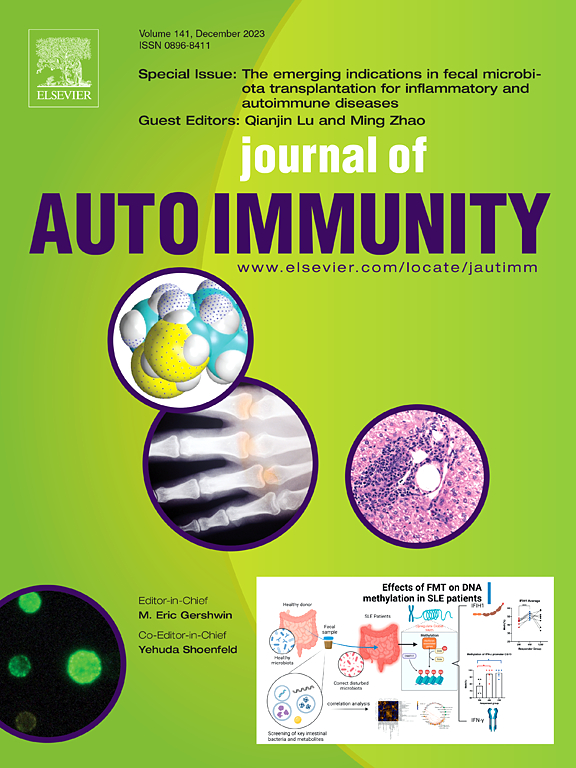Identification of clonally expanded T-cell receptor sequences in giant cell arteritis
IF 7
1区 医学
Q1 IMMUNOLOGY
引用次数: 0
Abstract
Background
Arterial wall inflammation in giant cell arteritis (GCA) is characterized by T-cell infiltration and granuloma formation. There have been limited studies investigating the diversity of the T-cell receptor (TCR) repertoire in GCA patients. Here we aim to identify disease-relevant TCRs.
Methods
We sequenced the TCRβ repertoires in peripheral blood and biopsies from 72 GCA patients and compared them to repertoires of 60 age-matched controls. Applying K-nearest neighbours classification based on tcrdist3, an established TCR similarity measure, we identified GCA-associated TCRs across multiple model hyperparameters and experimental replicates.
Results
We observed that species richness and Shannon diversity were significantly lower (P = 0.0003 and P = 0.004, respectively) in GCA peripheral blood TCR repertoires compared with age-matched controls. 1526 TCRs were identified that were consistently associated with GCA, 63 TCRs were also detected in TAB repertoires. Identical GCA-associated TCRs were observed in paired blood and tissue samples from 21/30 GCA cases. 57 % of GCA-associated TCRs were fitted into 10 clusters, which displayed distinct TCR sequences and TCR V and J segment usage. TRBV20-1∗01, TRBV4-3∗01, TRBV4-2∗01 and TRBV4-1∗01 segments were over-represented and occurred at least 10 % more often among GCA patients than age-matched controls. Only 27/1526 TCR sequences had matches reported in public databases, reducing the likelihood that these targeted common infectious agents.
Conclusions
Our data provide evidence of circulating T-cell clonal expansions in GCA patients. Certain TCR sequence patterns were over-represented in GCA subjects. As more TCR sequences directed at human antigens become available, further analysis may ultimately reveal whether these TCRs bind a common target antigen.
巨细胞动脉炎克隆扩增t细胞受体序列的鉴定
背景巨细胞动脉炎(GCA)的壁炎以t细胞浸润和肉芽肿形成为特征。关于GCA患者t细胞受体(TCR)库多样性的研究有限。在这里,我们的目标是确定与疾病相关的tcr。方法对72例GCA患者外周血和活检中的TCRβ谱进行测序,并与60例年龄匹配的对照组进行比较。应用基于tcrdist3(一种已建立的TCR相似性度量)的k近邻分类,我们在多个模型超参数和实验重复中识别出与gca相关的TCR。结果GCA外周血TCR库的物种丰富度和Shannon多样性显著低于同龄对照组(P = 0.0003和P = 0.004)。鉴定出1526个与GCA一致相关的tcr,在TAB谱中也检测到63个tcr。在21/30例GCA病例的配对血液和组织样本中观察到相同的GCA相关tcr。57%的gca相关TCR被分为10个簇,显示出不同的TCR序列和TCR V和J段的使用情况。TRBV20-1∗01,TRBV4-3∗01,TRBV4-2∗01和TRBV4-1∗01在GCA患者中过度代表,并且比年龄匹配的对照组发生的频率至少高10%。只有27/1526个TCR序列在公共数据库中报告了匹配,降低了这些序列靶向常见感染原的可能性。结论sour数据为GCA患者循环t细胞克隆扩增提供了证据。某些TCR序列模式在GCA受试者中被过度代表。随着更多针对人类抗原的TCR序列的出现,进一步的分析可能最终揭示这些TCR是否结合了共同的靶抗原。
本文章由计算机程序翻译,如有差异,请以英文原文为准。
求助全文
约1分钟内获得全文
求助全文
来源期刊

Journal of autoimmunity
医学-免疫学
CiteScore
27.90
自引率
1.60%
发文量
117
审稿时长
17 days
期刊介绍:
The Journal of Autoimmunity serves as the primary publication for research on various facets of autoimmunity. These include topics such as the mechanism of self-recognition, regulation of autoimmune responses, experimental autoimmune diseases, diagnostic tests for autoantibodies, as well as the epidemiology, pathophysiology, and treatment of autoimmune diseases. While the journal covers a wide range of subjects, it emphasizes papers exploring the genetic, molecular biology, and cellular aspects of the field.
The Journal of Translational Autoimmunity, on the other hand, is a subsidiary journal of the Journal of Autoimmunity. It focuses specifically on translating scientific discoveries in autoimmunity into clinical applications and practical solutions. By highlighting research that bridges the gap between basic science and clinical practice, the Journal of Translational Autoimmunity aims to advance the understanding and treatment of autoimmune diseases.
 求助内容:
求助内容: 应助结果提醒方式:
应助结果提醒方式:


